Arduino Boards
위키백과, 우리 모두의 백과사전.
아두이노 보드는 아두이노를 기반으로 여러 종류가 생산되어 판매되고 있다. 주로 AVR의 아트메가(ATmega)를 위주로 만들어 지고, ARM 계열도 포함되어 있다.[1]
| MCU | 아두이노 보드[1] | |
|---|---|---|
| AVR | ||
| ATmega168 | Pro(168), Mini(168), LilyPad (168V) | |
| ATmega328 | UNO, ETHERNET, Fio, Nano, Pro(328), Mini(328, Rev5), Pro Mini, LilyPad/Simple (328V) | |
| ATmega2560 | Mega 2560, Mega ADK | |
| ATmega32U4 | YÙN, Leonardo, Esplora, Micro, LilyPad USB, ROBOT(Control,Motor) | |
| ATtiny85 | GEMMA | |
| ARM | ||
| Cortex-M0+ | Zero, Zero Pro, M0, M0 PRO | |
| Cortex-M3 | Due |
상업용 아두이노 보드[편집]
- 아두이노 보드 예
쉴드 (Shield)[편집]
쉴드는 아두이노 보드의 마이크로컨트롤러와 호환 가능한 여러 부가 모듈을 커넥터로 연결하여 기능을 추가하는 부품이다. 주로 입출력 장치를 부가한다.
- 아두이노 쉴드
기타 부품[편집]
- 아두이노 보조
아두이노 제품[편집]
수 많은 아두이노 보드가 만들어져 사용되고 있다 :[2][3]
| 모델 | 프로세서 | 형상 | 호스트 인터페이스 | 입출력 | 출시일/공개일 | 요약 | ||||||||||
|---|---|---|---|---|---|---|---|---|---|---|---|---|---|---|---|---|
| 모양 | 모델명 | MCU | 동작 주파수 | 크기 | 인터페이스 | 동작전압 | 플래쉬 (KiB) | EEPROM (KiB) | SRAM (KiB) | 디지털(핀) | PWM (핀) | 아날로그 (핀) | ||||
| Arduino Uno[4][5] | ATmega328P[6] | 16 MHz | Arduino | 68.6x53.3mm [2.7x2.1 in] | USB | 8U2[7] (Rev1&2)/ 16U2[8] (Rev3) | 5 V | 32 | 1 | 2 | 14 | 6 | 6 | 2010-09-24[9] | Duemilanove 이후 모델로 ATmega328 사용. Duemilanove가 FTDI USB 칩을 사용하였으나 Uno는 ATmega16U2 (Rev3이전버전은 ATmega8U2)을 사용하여 시리얼 변환. | |
| Arduino Mega2560[10][11] | ATmega2560[12] | 16 MHz | Mega | 101.6x53.3mm [4x2.1 in] | USB | 8U2[7] (Rev1&2)/ 16U2[8] (Rev3) | 5 V | 256 | 4 | 8 | 54 | 15 | 16 | 2010-09-24[9] | 256 KiB 메모리. ATmega16U2(Rev3이전에는 ATmega8U2) USB 칩. Duemilanove, Diecimila, 또는 Uno 등의 모양과 맞추어져 있고 기타의 핀이 확장 됨. | |
 | Arduino Leonardo[13][14] | Atmega32U4[15] | 16 MHz | Arduino | 68.6x53.3mm [2.7x2.1 in] | USB | 32U4[15] | 5 V | 32 | 1 | 2.5 | 20 | 7 | 12 | 2012-07-23[16] | Leonardo는 Atmega32U4 사용, USB 컨트롤러가 장착. |
| Zero | Arduino Zero[17] Arduino Zero Pro[18] | ATSAMD21G18A[21] (ARM Cortex-M0+) | 48 MHz | Arduino | 101.6x53.3mm [4x2.1 in] | USB | Native & EDBG Debug | 3.3 V | 256 | 0~16Kb 에뮬레이션 | 32 | 14 | 12 | 6 | 출시일 2015-06-15[22] 공개 | 베타 테스트 2014-08-01[24] |
| Arduino Due[25][26] | ATSAM3X8E[27] (ARMCortex-M3) | 84 MHz | Mega | 101.6x53.3mm [4x2.1 in] | USB | 16U2[8] + native host[28] | 3.3 V | 512 | 0[29] | 96 | 54 | 12 | 12 | 2012-10-22[30] | 첫 ARM 프로세서 채용. 2채널 12비트 DAC(Digital-to-analog converter) 내장, 84Mhz 클럭, 32비트 구조, 512KB 플래쉬 & 96KiB SRAM. 동작 전원 3.3 V. | |
 | Arduino Yún[31] | Atmega32U4,[15] Atheros AR9331 | 16 MHz, 400 MHz | Arduino | 68.6x53.3 mm [2.7x2.1 in] | USB | 5 V | 32 kB, 16 MB | 1 kB, 0 kB | 2.5 kB, 64 MB | 14 | 6 | 12 | 2013-09-10[32] | Arduino Yún는 Arduino Leonardo(Atmega32U4)에 Wifi SoC(system on a chip)를 결합한 것으로, OpenWrt을 기반으로 한 MIPS GNU/Linux 이다. | |
| Arduino Fio[33] | ATmega328P[6] | 8 MHz | 소형 | 66.0x27.9mm [2.6x1.1 in] | XBee 시리얼/시리얼 | 3.3 V | 32 | 1 | 2 | 14 | 6 | 8 | 2010-03-18[34] | USB-XBee 소켓 연결 가능.[35] | ||
| Arduino Nano[36] | ATmega328[37] (ATmega168 v3.0이전버전[38]) | 16 MHz | 소형 | 43.18x18.54mm [1.70x0.73 in] | USB | FTDI FT232R[39] | 5 V | 16/32 | 0.5/1 | 1/2 | 14 | 6 | 8 | 2008-05-15[40] | 가장 작은 Arduino 버전으로 표면장착 프로세서. | |
| Arduino (Pro) Mini[41] | ATmega168[38] ATMega328(Pro) | 8 MHz (3.3 V 모델) or 16 MHz (5 V 모델) | 17.8x33.0mm [0.7x1.3 in] | 5 V or 3.3 V | 16 | 0.5 | 1 | 14 | 6 | 6 | 2008-08-23[42] | Arduino 축소 버전으로 표면장착 프로세서 사용. | ||||
| Arduino Micro[43] | ATmega32U4[15] | 16 MHz | 17.8x48.3mm [0.7x1.9 in] | 5 V | 32 | 1 | 2.5 | 20 | 7 | 12 | 2012-11-08[44] | Adafruit과 같이 디자인함. | ||||
| LilyPad Arduino[45] | ATmega168V or ATmega328V | 8 MHz | wearable | 51 mm⌀ [2 in ⌀] | 2.7-5.5 V | 16 | 0.5 | 1 | 14 | 6 | 6 | 2007-10-17[46] | 웨어러블(wearable) 응용 가능. | |||
| Arduino Pro [47] | ATmega168 or ATmega328[47] | 16 MHz | Arduino | 52.1x53.3mm [2.05x2.1 in] | UART 시리얼, I2C(TWI), SPI | FTDI | 5 V or 3.3 V | 16/32 | 0.5/1 | 1/2 | 14 | 6 | 6 | SparkFun Electronics에서 디자인하고 판매. | ||
| Arduino ADK | Arduino Mega ADK[48] | ATmega2560[12] | 16 MHz | Mega | 101.6x53.3mm [4x2.1 in] | 8U2[7]
| 5 V | 256 | 4 | 8 | 54 | 14 | 16 | 2011-07-13[49] | ||
| Arduino Ethernet[50] | ATmega328[37] | 16 MHz | Arduino | 68.6x53.3mm [2.7x2.1 in] | Ethernet 시리얼 인터페이스 | 328P | 5 V | 32 | 1 | 2 | 14 | 4 | 6 | 2011-07-13[49] | 위즈넷(WIZnet)의 W5100칩을 사용한 Arduino Ethernet Shield와 Pro가 합쳐짐. 마지막 버전에서 PoE(Power over Ethernet)지원. | |
 | Arduino Esplora[51] | Atmega32U4[15] | 16 MHz | 165.1x61.0mm [6.5x2.4 in] | 32U4[15] | 5 V | 32 | 1 | 2.5 | 2012-12-10 | 아날로그 조이스틱, 버튼 4개, 센서, 2 TinkerKit 입력 및 2 출력, LCD 커넥터 | |||||
대체 보드 (초기 보드)[편집]
기능이 향상 된 보드가 나오고 있으나, Duemilanove 등을 포함한 몇몇 보드는 여전히 널리 사용되고 있다.
| 모델 | 프로세서 | 형상 | 호스트 인터페이스 | 입출력 | 출시일/공개일 | 요약 | ||||||||||
|---|---|---|---|---|---|---|---|---|---|---|---|---|---|---|---|---|
| 모양 | 모델명 | MCU | 동작 주파수 | 크기 [mm] | 인터페이스 | 동작전압 | 플래쉬 (KiB) | EEPROM (KiB) | SRAM (KiB) | 디지털(핀) | PWM (핀) | 아날로그 (핀) | ||||
| Serial Arduino[52] | ATmega8[53] | 16 MHz | Arduino | 81.3x53.3 | DE-9 시리얼 연결 | native | "아두이노"라는 이름이 처음 붙음. | |||||||||
| Arduino USB[2] | ATmega8[53] | 16 MHz | Arduino | 81.3x53.3 | USB | FTDI FT232BM | RS-232 인터페이스를 USB로 대체되었고, 전원이 호스트로 부터 공급가능함. | |||||||||
| Arduino Extreme[2] | ATmega8[53] | 16 MHz | Arduino | 81.3x53.3 | USB | 이전 모델보다 더 많은 SMD 부품 사용.[2] | ||||||||||
| Arduino NG (Nuova Generazione)[2] | ATmega8[53] | 16 MHz | Arduino | 81.3x53.3 | USB | FTDI FT232RL | FT232BM 대신 FT232RL로 대체 되고, 핀 13에 LED 추가. | |||||||||
| Arduino NG plus | ATmega168[38] | 16 MHz | Arduino | 81.3x53.3 | USB | |||||||||||
| Arduino BT (Bluetooth)[54][55] | ATmega168[38] ATmega328[37] | 16 MHz | Arduino | 81.3x53.3 | Bluetooth | 168/328P | 5 V | 32 | 1 | 2 | 14 | 4 | 6 | 2007-10-22[56] | 블루투스 모듈을 통한 시리얼 통신.[54] | |
| Arduino Diecimila[57] | ATmega168 (DIP-28)[38] | 16 MHz | Arduino | 68.6x53.3 | USB | FTDI | 5 V | 16 | 0.5 | 1 | 14 | 6 | 6 | 2007-10-22[56] | 향상: 호스트 아두이노 리셋 가능, 리셋(reset)과 3.3 V 핀, 외부 전원으로 부터 전압변환. | |
| Arduino Duemilanove (2009)[58][59] | ATmega168,[38] ATmega328P (ATmega328 새 버전) | 16 MHz | Arduino | 68.6x53.3 | USB | FTDI | 5 V | 16/32 | 0.5/1 | 1/2 | 14 | 6 | 6 | 2008-10-19[60] | 향상 : USB와 외부 전원 공급 자동전환. | |
| Arduino Mega[61][62] | ATmega1280[63] | 16 MHz | Mega | 101.6x53.3 | USB | FTDI | 5 V | 128 | 4 | 8 | 54 | 14 | 16 | 2009-03-26[64] | SMD ATmega1280 사용.[65] | |
아두이노 파생 상품[편집]
하드웨어 및 소프트웨어 디자인을 카피 레프트 라이선스에 따라 자유롭게 사용할 수 있지만, 공식 제품 독점하고 허가없이 개발자는 '아두이노' 이름을 파생 제품에 사용하지 않는 것이 요청했습니다. 아두이노 이름의 사용에 대한 공식 정책 문서는 프로젝트의 공식 제품으로 다른 사람이 작업을 통합에 열려 있음을 강조하고있다.[3]
Arduino 보호 명명 규칙의 결과, 아두이노 사용자 그룹은 Arduino Diecimila 갈래 인 Freeduino라고 등가 보드를 출시했다. 'Freeduino'라는 이름의 상표는 어떤 목적으로 자유롭게 사용할 수 없습니다.[66]
상업적으로 출시 된 여러 아두이노 호환 제품은 "-duino"이름의 변형을 사용하여 '아두이노' 이름을 피했다.[66]
Arduino footprint-compatible boards[편집]
다음 보드는 '쉴드' 보드를 수용 할 수있는 것을 포함하여, 완전히 또는 거의 완전히 아두이노 하드웨어 및 소프트웨어와 호환된다.
| Name | Processor | Maker | Notes | |
|---|---|---|---|---|
| Linduino One | ATmega328 | Linear Technology Corporation[67] | Compatible with Arduino Uno. Galvanically isolated USB interface provided by onboard LTM2884 USB Isolation module. | |
| InVentor UNO[68] | ATmega328P-PU | Ventor Technologies[69] | Added Features:
| |
| Bluno | ATmega328 | DFRobot.com | Added Features:
| |
| AVR.duino U+ | ATmega328 | SlicMicro.com |  Added Features: Added Features:
| |
| SainSmart UNO[70] | ATmega328 | SainSmart[71] | 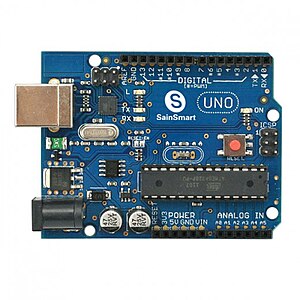 | |
| SainSmart Mega 2560[72] | ATmega2560[12] | SainSmart[71] | 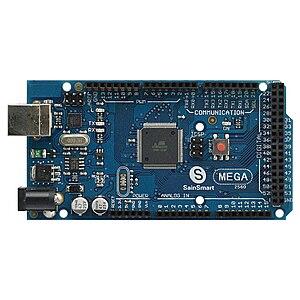 | |
| Freaduino MEGA2560[73] | ATmega2560[12] | ElecFreaks[74] |
| |
| SainSmart UNO R3[75] | ATmega328-AU | SainSmart[71] |  Controller: SMD MEGA328P-AU; A6/A7 port added; 3.3 V/5 V supply voltage and I/O voltage switch. Controller: SMD MEGA328P-AU; A6/A7 port added; 3.3 V/5 V supply voltage and I/O voltage switch. | |
| AVR-Duino[76] | TavIR[77] | Another Arduino/Mega compatible board. | ||
| Brasuíno[78] | Holoscópio[79] |  Based on the Uno with rearranged LEDs and reset button, mini-USB connector, and altered pin 13 circuitry so that the LED and resistor do not interfere with pin function when acting as an input. The Brasuíno was designed using KiCad, and is licensed as GPLv2. Based on the Uno with rearranged LEDs and reset button, mini-USB connector, and altered pin 13 circuitry so that the LED and resistor do not interfere with pin function when acting as an input. The Brasuíno was designed using KiCad, and is licensed as GPLv2. | ||
| ChibiDuino2[80] | ATmega328 | TiisaiDipJp[80] |  Japanese Arduino compatible kit using Uno board setting. Includes two mini-B USB sockets, 1602 LCD socket, 5 V or 3.3 V power selection, breadboard area. Japanese Arduino compatible kit using Uno board setting. Includes two mini-B USB sockets, 1602 LCD socket, 5 V or 3.3 V power selection, breadboard area. | |
| Cosmo Black Star[81] | ATmega328 | JT5[82] | Arduino layout-compatible board. Based on the Arduino Duemilanove. | |
| CraftDuino[83] | Manufactured and sold by RoboCraft Team. | |||
| Diavolino[84] | Evil Mad Scientist Laboratories |  Arduino layout-compatible board, designed for use with a USB-TTL serial cable. Arduino layout-compatible board, designed for use with a USB-TTL serial cable. | ||
| DuinoBot v1.x[85] | ATmega32U4 | RobotGroup Argentina[86] | Arduino fully compatible board, with integrated power supply and controllers designed for robotics. Compatible as well with the system "Multiplo" | |
| eJackino[87] | Kit by CQ publisher in Japan. | Similar to Seeeduino, eJackino can use Universal boards as Shields. On back side, there is a "Akihabara station" silk, just like Italia on Arduino. | ||
| Freeduino MaxSerial[88] | Manufactured and sold assembled or as a kit by Fundamental Logic until May 2010. | A board with a standard DE-9 serial port. | ||
| Freeduino SB[89] | ATmega328 | Solarbotics Ltd.[90] |  Compatible with the Duemilanove. Compatible with the Duemilanove. | |
| Freeduino Through-Hole[91] | Manufactured and sold as a kit by NKC Electronics. | The design avoids surface-mount soldering. | ||
| Illuminato Genesis[92] | ATmega644 | Provides 64 kB of flash, 4 kB of RAM and 42 general I/O pins. Hardware and firmware are open source. | ||
| InduinoX[93] | ATmega168/ATmega 328/ATmega 8 | Simple Labs[94] | A low cost Arduino clone using the ATmega168/ATmega 328/ATmega 8 and designed for prototyping, it includes onboard peripherals such as an RGB LED, switches, IR Tx/Rx and DS1307 real-time clock(RTC). | |
| Japanino[95] | ATmega168[38] | A kit by Otonano Kagaku publisher in Japan. | The board and a POV kit were included in Vol. 27 of the eponymous series. It is unique in having a regular size USB A connector. | |
| 1000Pads Luigino[96] | Minimalistic version of Arduino: small, without serial converter. Available as a kit, board only or assembled. Smaller than Arduino, with different footprint. | |||
| Luigino328[97] | ATmega328 | It has an improved automatic voltage selector, resolves problems during programming caused by shields that use the serial port, with an automatic serial port selector, and has the LM1117 voltage regulator. | ||
| metaboard[98] | Developed by Metalab, a hackerspace in Vienna. | Designed to have a very low complexity and price. Hardware and firmware are open source. | ||
| Rascal | AT91SAM9G20 (ARM9) | Rascal Micro[99] | It is compatible with Arduino shields, but it is programmed in Python rather than C++. It has an embedded webserver. | |
| Raspduino[100] | ATmega328 | Bitwizard[101] | Fully Arduino compatible board, that fits perfectly on a Raspberry Pi, and can be programmed through the Raspberry Pi's serial interface. It also breaks out the Raspberry Pi's SPI and I²C interfaces, or can be used as a stand-alone Arduino when powered with the external power header. | |
| Romeo 2012[102] | ATmega328 | DFRobot[103] | An all-in-one Arduino with motor controller. Compatible with the Arduino Uno.  | |
| Roboduino[104] |  Designed for robotics. All connections have neighboring power buses (not pictured) for servos and sensors. Additional headers for power and serial communication are provided. It was developed by Curious Inventor, LLC. Designed for robotics. All connections have neighboring power buses (not pictured) for servos and sensors. Additional headers for power and serial communication are provided. It was developed by Curious Inventor, LLC. | |||
| Seeeduino[105] | v2.21 (Atmega168 or Atmega328) v3.0 (Atmega328) | SeeedStudio |  Derived from the Diecimila. This photo is v1.0b. Derived from the Diecimila. This photo is v1.0b. | |
| SunDuino[106] | ATmega8/88/168/328/16/32/324/644 and PIC18F2550/4550 PIC32MX320F128 and ButterFLY, STM32Discovery | Lothar Team Arduino PRO Compatible boards. (Poland) | Another Arduino compatible board, software- and hardware-compatible. | |
| TwentyTen[107] | Freetronics[108] |  Based on the Duemilanove, with a prototyping area, rearranged LEDs, mini-USB connector, and altered pin 13 circuitry so LED and resistor do not interfere with pin function when acting as an input. Based on the Duemilanove, with a prototyping area, rearranged LEDs, mini-USB connector, and altered pin 13 circuitry so LED and resistor do not interfere with pin function when acting as an input. | ||
| UDOO | Atmel SAM3X8E | SECO Inc. | Android-Linux-Arduino compatible board. | |
| Volksduino[109] | Applied Platonics[110] | A low cost, high power, shield-compatible, complete Arduino-compatible board kit. Based on the Duemilanove, it comes with a 5 V / 1 A voltage regulator (optional 3.3 V regulator). Designed for low component count and for ease of assembly. | ||
| Wiseduino[111] | Includes a DS1307 RTC with backup battery, a 24LC256 EEPROM and a connector for XBee adapter for wireless communication. | |||
| Xaduino | ATXmega128A3U | OBDIIworld[112] | 8/16 bit Xmega core @ 32 MHz. 8 KB SRAM. 37 Digital I/O. 3.3 V. 2 DAC. Output 3.3 V pin: 500 mA, 5 V 500 mA. | |
| YourDuinoRoboRED | Atmel 328 | Yourduino.com[113] | Includes 14 color-coded 3-pin connectors for direct cable connection of servos, electronic bricks, etc., and 6 color-coded3-pin connectors to Analog inputs for electronic bricks, etc. Provides improved 3.3 V regulator supplying 500 mA, and optional 3.3 V operation. Switching regulator provides 5V 2A from up to 20V external supply. | |
| YourDuinoRobo1[114] | Atmel 328 | Yourduino.com[113] | Includes 6 color-coded 3-pin connectors for direct cable connection of servos, electronic bricks, etc., and 6 3-pin connectors to Analog inputs for electronic bricks, etc. Provides improved 3.3 V regulator supplying 500 mA, and optional 3.3 V operation. | |
| ZArdino[115] | A South African Arduino-compatible board derived from the Duemilanove, it features mostly through-hole construction except for the SMD FT232RL IC, power selection switches, option for a Phoenix power connector instead of DC jack, extra I/O pads for using Veroboard as shields. Designed for easy assembly in countries where exotic components are hard to find. | |||
| Zigduino[116] | ATmega128RFA1 | Logos Electromechanical[117] |  Integrates ZigBee (IEEE 802.15.4). It can be used with other 802.15.4 network standards as well as ZigBee. It is the same shape as the Duemilanove, includes an external RPSMA jack on the side of the board opposite the power jack, and is compatible with shields that work with other 3.3 V boards. Integrates ZigBee (IEEE 802.15.4). It can be used with other 802.15.4 network standards as well as ZigBee. It is the same shape as the Duemilanove, includes an external RPSMA jack on the side of the board opposite the power jack, and is compatible with shields that work with other 3.3 V boards. | |
| EtherTen[118] | ATmega328P | Freetronics | Fixed SPI behaviour on Ethernet chip, D13 pin isolated with a MOSFET of which can also be used as an input. | |
| EtherMega[119] | ATmega2560[12] | Freetronics | Fixed SPI behaviour on Ethernet chip, Micro SD card slot, D13 pin isolated with a MOSFET of which can also be used as an input. | |
| USBDroid[120] | ATmega328P | Freetronics | Can act as a host for an Android device and is compatible with the Android Open Accessory Development Kit, Micro SD card slot, D13 pin isolated with a MOSFET of which can also be used as an input. | |
| Eleven[121] | ATmega328P | Freetronics | Arduino Uno compatible, D13 pin isolated with a MOSFET of which can also be used as an input. | |
| KitTen[122] | ATmega328P | Freetronics | Includes both 3.3V and 5V regulators for shields, D13 pin isolated with a MOSFET of which can also be used as an input. Can be connect to Arduino using CAT5 cable.[123] | |
| EtherDue[124] | ATSAM3X8E [27] (Cortex-M3) | Freetronics | Arduino Due with onboard Ethernet, software-compatible with Arduino Ethernet Shield, D13 pin isolated with a MOSFET of which can also be used as an input. | |
| TAIJIUINO Due Pro [125] | ATSAM3X8E [27] (Cortex-M3) | Elechouse | Mostly compatible with Arduino Due. Includes RMII signals via a connector to allow access to the microcontroller's native Ethernet MAC. |
특수목적 아두이노 호환 보드[편집]
특수 목적 아두이노 호환 보드는 특정 응용 프로그램에 최적화 된 별도의 하드웨어를 추가할 수 있다. 이것은 아두이노 단일 보드에 쉴드를 추가하는 것과 같다. 일부는 쉴드와 호환된다.
| Name | Processor | Shield-compatible? | Host interface | Maker | Additions |
|---|---|---|---|---|---|
| Io:duino[126] | AT90CAN128 | yes | USB with FTDI serial chip | Railstars | Adds built-in CAN support through the AT90CAN128 micro processor, dual RJ45 jacks, and optional bus termination. Designed specifically for model railroading applications using the OpenLCB networking protocol, the hardware is sufficiently generic for use with other low-speed CAN networks. |
| DFRobotShop Rover[127] | ATmega328 | The is a minimalist tracked platform based on the Arduino Duemilanove. Has an ATmega328 with Arduino bootloader, a dual H-bridge and additional prototyping space and headers. It is compatible with many shields, though four digital pins are used when operating the motor controller. Has an onboard voltage regulator, additional LEDs, a temperature sensor, and a light sensor. Part of the DFRobotShop Rover kit. | |||
| Industruino[128] | Atmega 32u4 or Atmega AT90USB1286 | No | USB | Arduino compatible industrial controller housed in DIN rail casing, designed for industrial automation in small to medium sized businesses. | |
| Faraduino[129] | ATmega328 | Yes | USB with FTDI serial chip | Developed by Middlesex University Teaching Resources.[130] |  Simple shield-compatible board, with onboard discrete transistor H-bridges and screw terminals to drive two small DC motors from pins 4-7.[131] Has headers for three servos on pins 9-11. Simple shield-compatible board, with onboard discrete transistor H-bridges and screw terminals to drive two small DC motors from pins 4-7.[131] Has headers for three servos on pins 9-11.  Also sold with the Faraduino buggy kit[132] and Faraconnect shield[133] as a simple school-level teaching robot. Also sold with the Faraduino buggy kit[132] and Faraconnect shield[133] as a simple school-level teaching robot. |
| Lightuino[134] | ATmega328p[135] | Produced as a stand-alone '328 Arduino-compatible board and as a shield. It directly drives LEDs (70 constant-current channels) or LED matrices (1100 LEDs), and has an adjustable LED voltage regulator, an ambient light sensor, and an IR receiver. | |||
| Motoruino[136] | ATmega328 | Yes | Serial only, 6 pin header | Guibot | 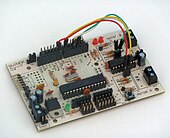 Has L293D twin H-bridge. Has L293D twin H-bridge. |
| ArduPilot[137] | An Arduino-compatible board designed for auto-piloting and autonomous navigation of aircraft, cars, and boats. It uses GPS for navigation and thermopile sensors or an IMU for stabilization. | ||||
| ArduIMU[137] | An Arduino-compatible board designed for Inertial Measurement and Inertial Navigation navigation of aircraft, cars, and boats. It uses the ATMEGA128RFA1 and a variety of sensors IMU for various applications. | ||||
| FlyDuino Mega[138] | ATmega 2560[12] | Serial only, 6 pin header | Paul Bake | An Arduino Mega 2560 compatible board designed for auto-piloting and autonomous navigation of multirotor aircraft. Designed to be stacked with sensor bobs and boards with several breakout boards available. | |
| Colibri[139] | ATmega168[38] | No | Serial only | JT5[82] | Universal Platform for Wireless Data Transmission in the Frequency Band 868 MHz. The Board Combines Features Arduino Mini and the Radio EZRadioPRO for Receiving and Transmitting Data. With dataFlash. |
| JeeNode[140] | ATmega328 | 6 pin header | Jeelabs | Includes a wireless radio module, called the RFM12B by HopeRF | |
| ArduPhone[141] | ATmega1284P | yes | USB | Freetronics | Cellular phone kit, ADH8066 GSM module, Micro SD slot, 16 key matrix keyboard, LiPo charger and microphone/speaker connectors. |
| Tah[142] | ATmega32u4 | Yes | USB | Revealing Hour Creations[143] | Stock Arduino Leonardo With a built-in BLE(Bluetooth Low Energy) 4.0. Has arduino compatibility with its breakout shield . |
| WIOT | ATmega32u4 | No | USB | ubld.it | WIOT is an Open Source, rechargeable, Li-Ion battery powered, Arduino compatible, development board designed around the ATmega32U4 Processor and ESP8266 Wi-Fi Module. |
소프트웨어 만 호환 가능보드[편집]
이 보드는 아두 이노 소프트웨어와 호환하고, 표준 쉴드를 사용할 수 없다. 이 보드들은 전원 및 입출력 커넥터는 다른 연결 방법을 사용한다. 브래드보드 등과 연결 할수 있다. 아두이노 호환 보드 설계자에 의한 선택의 중요한 하나는 보드에 USB 회로를 포함 할 것인지 여부이다. 저렴하게 개발 및 PC 보드 사이의 케이블을 연결할 수 있는 배치를 갖는다. 장치가 프로그램 된 후, Arduino 들이 USB 회로가 중복된다.
| Name | Processor | Maker | Notes |
|---|---|---|---|
| Ardweeny[144] | Solarbotics | An inexpensive, even more compact breadboardable device. | |
| Banguino[145] | ATmega328 | Dimitech |  Enhanced Arduino-Uno-compatible in standard PLCC68 socket Enhanced Arduino-Uno-compatible in standard PLCC68 socket |
| Bare Bones Board[146] (BBB) and Really Bare Bones Board[147] (RBBB) | Modern Device | Compact inexpensive Arduino-compatible board suitable for breadboarding. | |
| BlockDuino[148] | ATmega8 ATmega328 | Blockduino | An Arduino-Diecimila-compatible board with serial connection to Blocks (shields).[149] |
| Boarduino[150] | ATmega168 or ATmega328 | Adafruit | 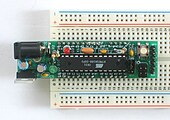 An inexpensive Arduino-Diecimila-compatible board made for breadboarding. An inexpensive Arduino-Diecimila-compatible board made for breadboarding. |
| Breaduino[151] | Applied Platonics[110] | A complete, very low cost Arduino-compatible kit that can be assembled entirely on a breadboard. | |
| Croduino Basic[152] | ATmega328 | e-radionica.com | Inexpensive fully compatible Arduino board for schools and DIY individuals in Croatia. |
| Cardboarduino[153] | ATmega168[38] | Inspired by the Paperduino, an ultra low-cost Arduino compatible, built on printed posterboard, rather than a PCB. | |
| Crumbuino-Nano[154] | ATmega328 | chip45.com/[155] | The Crumbuino-Nano is a low-cost module comparable to the Arduino-Nano and can be used as Arduino-Nano in the Arduino-IDE. The Arduino bootloader is preloaded, hence the module is ready-to-use. The documentation shows the pin mapping of Arduino-naming to module pinout. |
| Crumbuino-Mega[156] | ATmega2560[12] | chip45.com/[155] | The Crumbuino-Mega is a low-cost module comparable to the Arduino-Mega 2560 and can be used as Arduino-Mega 2560 in the Arduino-IDE. The Arduino bootloader is preloaded, hence the module is ready-to-use. The documentation shows the pin mapping of Arduino-naming to module pinout. |
| Digispark[157] | ATTiny85 | Digistump[158] | Built-in USB plug. Requires special version of the Arduino IDE. |
| DragonFly[159] | ATmega1280[63] | A compact board with Molex connectors, aimed at environments where vibration could be an issue. DragonFly features the ATmega1280 and have all 86 I/O lines pinned out to connectors. | |
| Femtoduino[160][깨진 링크] | ATmega328P-MU | Femtoduino[161] | An ultra-small (20.7x15.2 mm) Arduino compatible board designed by Fabio Varesano. Femtoduino is currently the smallest Arduino compatible board available.[출처 필요] |
| Freeduino USB Mega 2560[162] | ATmega2560[12] | Bhasha Technologies[163] | Freeduino USB Mega 2560 is a cost effective and 100% pin and software compatible to the popular Arduino Mega 2560. Uses through hole components and has male headers. |
| Freeduino Lite v2[164] | ATmega8/168/328 | Bhasha Technologies[163] | Freeduino Lite v2 is a low cost, Freeduino with no USB and Serial port. Needs FTDI USB Cable or FTDI Breakout board for programming. Uses through hole components and has male headers. |
| Freeduino Serial[165] | ATmega8/168/328 | Bhasha Technologies[163] | Freeduino Serial is a low cost Freeduino board with serial DB9 connector. Uses MAX232 Chip for Serial connectivty. |
| Freeduino NANO[161] | ATmega328 | Bhasha Technologies[163] | Freeduino Nano is a low cost Arduino Nano compatible board with mini USB connector using SMD components Freeduino Nano. |
| iDuino[160][깨진 링크] | A USB board for breadboarding, manufactured and sold as a kit by Fundamental Logic. | ||
| IMUduino[166] | ATMega32u4 | Femtoduino.com[167] | The world's first wireless 3D position, inertia, and orientation beacon. Designed in the San Francisco bay area, this board provides a 10-DoF IMU with on-board ATMega32u4 chip (the same as the Arduino Leonardo). |
| JeeNode[168] | ATmega328P | JeeLabs[169] |  Low-cost, low-size, radio-enabled Arduino-compatible board running at 3.3 V. Inspired by the Modern Device RBBB (above) with a HopeRF RFM12B wireless module and a modular I/O design supporting a wide range of interfaces.[170] Low-cost, low-size, radio-enabled Arduino-compatible board running at 3.3 V. Inspired by the Modern Device RBBB (above) with a HopeRF RFM12B wireless module and a modular I/O design supporting a wide range of interfaces.[170] |
| LCDuino[171] | ATmega328P | Geppetto Electronics | A combination of an ATMega328P and an i2c based RGB backlit LCD interface (software compatible with the Adafruit RGB LCD shield), along with a USB serial programming interface done as a "backpack" module for the LCD. |
| LEDuino[172] | A board with enhanced I²C, DCC decoder and CAN-bus interfaces. Manufactured using surface mount and sold assembled by Siliconrailway. | ||
| Moteino[173] | ATmega328P | LowPowerLab[174] | An SD-card size wireless-enabled breadboard friendly Arduino compatible board running at 16 MHz/3.3 V. It can mate with either an RFM12B or RFM69W/HW/CW transceiver from HopeRF, allowing very low cost wireless communication (also available without a transceiver). Programmable from the Arduino IDE through an FTDI cable/adapter, or directly through the USB interface (Moteino-USB revision). Moteino runs DualOptiboot,[175] a custom version of Optiboot that allows wireless programming when external FLASH memory is present. The new MoteinoMEGA based on Atmega1284P offers more IO, an extra hardware serial port, a massive 128KB of flash for sketches and 16KB of RAM (8X more!). |
| NavSpark[176] | Venus822 (Leon3 SPARC V8 compatible, 100 MHz 32-bit RISC) | SkyTraq[177] | The modified Arduino IDE allows the compiled user sketch to be uploaded onto the processor either with or without the proprietary GNSS software. NavSpark has 17 GPIO pins, which include two UARTs, 1 I²C, 1 SPI, 1 PWM, and a trigger. The first UART is usually used by the GNSS software to output NMEA 0183 data, although this can be disabled. This UART communicates over USB through a PL2303 serial converter and the transmit output is also made available on a pin. A 1 pulse per second signal is produced on a dedicated pin when a valid fix has been made. There is a GPS-only version, a combined GPS/GLONASS version, and a GPS/Beidou version. An adaptor board adds a JST connector for a lithium-ion battery, a charger for the battery, and a microSD card slot connected to the SPI pins. |
| NB1A[178] | An Arduino-compatible board that includes a battery backed up real-time clock and a four channel DAC. Most Arduino-compatible boards require an additional shield for these resources. | ||
| NB2A[179] | Sanguino-compatible board that includes a battery backed up real-time clock and a two channel DAC. Sanguino's feature the ATmega644P, which has additional memory, I/O lines and a second UART. | ||
| Nymph[180] | ATmega328P | A compact board with Molex connectors, aimed at environments where vibration could be an issue. | |
| Oak Micros om328p[181] | An Arduino Duemilanove compacted down to a breadboardable device (36 mm x 18 mm) that can be inserted into a standard 600 mil 28-pin socket, with USB capability, ATmega328P, and 6 onboard LEDs. | ||
| OpenTag[182] | ATmega328p | Loggerhead Instruments | 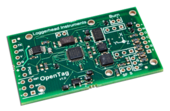  Arduino-compatible microSD motion datalogging board with accelerometer, magnetometer, gyroscope, pressure, temperature and real-time clock. Arduino-compatible microSD motion datalogging board with accelerometer, magnetometer, gyroscope, pressure, temperature and real-time clock. |
| Paperduino[183] | ATmega168 | An ultra low-cost Arduino compatible, built on a printed paper and cardboard substrate, rather than a PCB. | |
| PicoDuino [184] | ATTiny85 | Peter Misenko |
|
| Rainbowduino[185] | An Arduino-compatible board designed specifically for driving LEDs. It is generally used to drive an 8x8 RGB LED matrix using row scanning, but it can be used for other things. | ||
| Sanguino[186] | ATmega644 |  An open source enhanced Arduino-compatible board that uses an ATMega644P instead of an ATmega168. This provides 64 kB of flash, 4 kB of RAM and 32 general I/O pins in a 40 pin DIP device. It was developed with the RepRap Project in mind. An open source enhanced Arduino-compatible board that uses an ATMega644P instead of an ATmega168. This provides 64 kB of flash, 4 kB of RAM and 32 general I/O pins in a 40 pin DIP device. It was developed with the RepRap Project in mind. | |
| Seeeduino Mega[187] | ATmega2560[12] | SeeedStudio | Arduino Mega compatible board with 16 extra I/O pins and the same a board size as the Arduino Uno. As with the Arduino Mega, most shields that were designed for the Duemilanove, Diecimila, or Uno will fit, but a few shields will not fit because of interference with the extra pins. |
| Sippino[188] | SpikenzieLabs | A miniature Arduino compatible board with all of the digital and analog IO pins brought out into a single line of pins (SIP). Available as a kit, intended for use with a solderless breadboard. | |
| SODAQ Mbili[189] | ATmega1284P | SODAQ | The Raspberry Pi-sized SODAQ board is built for Solar Powered Data Acquisition. It is fitted with a Lipo charge controller and 12 Grove sockets for plug and play prototyping. It runs at 3.3 V and 8 MHz. It also comes with a DS3231 Real Time Clock and 16 Mbit serial flash for data logging. Its "bee" socket can use a range of different modules, like Xbee, RFbee, Bluetoothbee and GPRSbee to make the board communicate. The latest version has the powerful ATmega1284P microcontroller with 128k program space and 16k RAM and is still Arduino IDE compatible. Specifications:
|
| Sparrow[190] | ATMega328P | Open Home Automation | Arduino compatible board designed specifically for RF mesh network experiments. It features 10 IOs, an 10 pin ISP programming connector, a connector for a standard LCD display (in 4 bit mode) and a connector for an 2.4Ghz RF module. |
| Spider Controller[191] | Arduino Mega compatible board designed specifically for robots requiring large numbers of servos. A built in 3 A switchmode power supply allows servos to plug directly into the board. Pin spacing allows making custom shields from standard prototype board. | ||
| Stickduino[192] | Similar to a USB key. | ||
| Teensy[193] and Teensy++[193] | A pair of boards from PJRC.com that run most Arduino sketches using the Teensyduino software add-on to the Arduino IDE. | ||
| Teensy 3.1[194] | A very small board from PJRC.com based on the Freescale MK20DX128VLH5 32-bit ARM Cortex-M4 48 MHz CPU. It has 34 I/O pins; 128 kB of flash; 16-bit ADC; UARTs, SPI, I²C, Touch and other I/O capability. | ||
| TinyDuino[195] | ATmega328p | TinyCircuits[196] |  A fully capable Arduino platform smaller than a quarter, yet with all the power and functionality of the Arduino Uno board, including stackable shield support. The TinyDuino also support an option coin cell holder and has many expansion shields available. A fully capable Arduino platform smaller than a quarter, yet with all the power and functionality of the Arduino Uno board, including stackable shield support. The TinyDuino also support an option coin cell holder and has many expansion shields available. |
| TinyLily[197] | ATmega328p | TinyCircuits[196] |  A fully capable Arduino platform smaller than a dime, designed for e-textiles. Includes large sewtabs and a header for a USB adapter for communication and programming. A fully capable Arduino platform smaller than a dime, designed for e-textiles. Includes large sewtabs and a header for a USB adapter for communication and programming. |
| Trinket[198] | ATTiny85 | Adafruit | Requires updates to Arduino IDE (or download special version) and driver under Windows. Includes regulator for battery power away from PC. Very low cost. |
| Wireless Widget[199] | A compact (35 mm x 70 mm), low voltage, battery powered Arduino-compatible board with onboard wireless capable of ranges up to 120 m. The Wireless Widget was designed for both portable and low cost Wireless sensor network applications. | ||
| ZB1[200] | An Arduino-compatible board that includes a Zigbee radio (XBee). The ZB1 can be powered by USB, a wall adapter or an external battery source. It is designed for low-cost Wireless sensor network applications. | ||
| SunDuino2[106] | ATmega16/32/324/644 | An open source enhanced Arduino-compatible board that uses an ATmega16/32/324/644 instead of an ATmega168. This provides 16/32/64 kB of flash, and 32 general I/O pins in a 40 pin DIP device. | |
| OpenEnergyMonitor emonTx[201] | ATmega328 |  An open-source low power wireless (RFM12B) energy monitoring node based on ATmega328 and JeeNode design and uses the Nanode (another Arduino compatible) design for their receiver.[202] An open-source low power wireless (RFM12B) energy monitoring node based on ATmega328 and JeeNode design and uses the Nanode (another Arduino compatible) design for their receiver.[202] | |
| panStamp[203] | ATmega328 | panStamp[203] | 파일:PANSTAMP.JPG Small low-power wireless motes and base boards. Communication library, configuration tools and automation applications are available for panStamps. These wireless miniatures can easily be hooked to different cloud data services via Lagarto,[204] an open automation platform developed for panStamps.[203] |
| Microduino[205][206] | ATmega168/328/644/1284 | Microduino Studio | 1" x 1.1" small, stackable, low-cost Arduino-compatible board with a uniformed U-shape 27-pin standard interface. |
| Versalino Uno[207] | ATmega328p | Virtuabotix | Compact board with pins in two similar layouts "Bus A" and "Bus B". 6 volt input 3.5 mm plug power. Programmed with FTDI. |
| LeoStick[208] | ATmega32U4 | Freetronics | Compact version of the Arduino Leonardo (which can be plugged straight into a USB port without a cable) and has a buzzer and a 3-in-1 RGB LED. |
ATMEGA를 사용하지 않는 다른 마이크로컨트롤러 사용 보드[편집]
다음은 ATMEGA을 사용하지 않고, 자식 쉴드 보드를 수용한다. 마이크로컨트롤러 자체는 공식 아두이노 IDE와 호환되지 않는다. 하지만 그들은 아두이노 IDE와 호환되는 소프트웨어 라이브러리의 버전을 제공한다.
| Name | Processor | Host interface | Maker | Notes |
|---|---|---|---|---|
| PIC.duino Net | PIC18F67J60 | Ethernet or Serial | SlicMicro | Pin compatible with Arduino but uses the ethernet enabled PIC microcontroller to connect to the Internet. Allows sending of email, display of javascript enabled webpages, and remote web based access and control from around the world. |
| Leaflabs Maple[209] | STM32 (Cortex-M3) | USB | LeafLabs[210] | 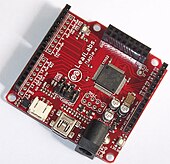 A 72 MHz 32-bit ARM Cortex-M3-based microcontroller (ST Microelectronics] STM32F103[211]) with USB support, compatibility with Arduino shields, and 39 GP I/O pins. Programmable with the Open Source Maple IDE,[212] which is a branch of the Arduino IDE. The Maple IDE includes both an implementation of the Arduino Language,[213] and lower-level native libraries (with support from the libmaple C library).[214] A 72 MHz 32-bit ARM Cortex-M3-based microcontroller (ST Microelectronics] STM32F103[211]) with USB support, compatibility with Arduino shields, and 39 GP I/O pins. Programmable with the Open Source Maple IDE,[212] which is a branch of the Arduino IDE. The Maple IDE includes both an implementation of the Arduino Language,[213] and lower-level native libraries (with support from the libmaple C library).[214] |
| Microchip chipKIT Uno32 and chipKIT Max32 | PIC32 | USB | Digilent[215] | 32-bit MIPS-M4K PIC32 processor boards. The Arduino libraries have been implemented natively for the PIC32 and these kits run in a fork of the standard Arduino IDE, chipKIT32-MAX[216] and are compatible to most shields.[217][218][219] |
| Freescale Freedom[220] | Kinetis-L (Cortex-M0+) | USB | Freescale[221] | A 48 MHz 32-bit ARM Cortex-M0+-based microcontroller (Freescale MKL25Z128VLK4[222]) with USB support, compatibility with Arduino shields and 64 GP I/O pins. Board embeds the new ARM OpenSDA debug and programming interface through USB and is compatible with the majority of the ARM IDE suppliers. |
| PRO Family[223] | ARM Cortex LPC1114 LPC1751 LPC1756 | USB | Coridium[224] | up to 200 MHz dual core ARM Cortex-M4F, ARM Cortex-M3 and ARM7TDMI-based shield-compatible boards, programmable in BASIC or C with Sketch support with open source MakeItC utilities. All boards have 5 V tolerant IOs. |
| Energia | MSP430 | USB | Texas Instruments | The Energia project integrates this with the Arduino IDE.[225][226] |
| Sakura board[227] | Renesas RX63N | USB | Renesas/Wakamatsu Tsusho Co.,Ltd | Web compiler with Sketch support,[228] ethernet interface |
비-아두이노 보드[편집]
다음 보드는 아두이노 호환 보드로 취급된다. 이 보드는 아두이노 IDE와 호환 되는 마이크로컨트롤러를 사용하지 않으며,[229] 아두이노 IDE 및 소프트웨어 라이브러리의 대체 구현 방법을 제공한다.
| Name | Processor | Maker | Notes |
|---|---|---|---|
| Chipino[230] | PIC16F886-I/SP[231] | Howtronics[232] | Chipino is an electronics prototyping platform based on a Microchip PIC microcontroller. It was designed to use the same footprint and connection scheme as the official Arduino boards to allow Arduino shields to be used with Chipino. |
| Bambino 210 | NXP LPC4330 | Microint USA | Dual core ARM Cortex-M4/M0, 264 KB SRAM, 4 MB Flash, mbed HDK, Arduino-compatible headers. The Bambino 210E has the same features as the 210, but adds a 10/100 Ethernet port, 8MB Flash, microSD socket, and Xbee Socket |
| Cypress PSoC 4 Pioneer Kit (CY8CKIT-042) | Cypress PSoC4 CY8C4245AXI-483 | Cypress | The PSoC 4 Pioneer Kit is a development platform enabling users to design with the ARM Cortex-M0 PSoC®4 device family. The kit features the PSoC 4200 device family as the main processor and includes a PSoC 5LP (ARM Cortex-M3 processor) to perform programming and debugging. The kit is supported using PSoC Creator, which is a free IDE for embedded development targeting the PSoC 3/4/5LP device families. In the summer of 2013 Cypress supported the kit with a 100 projects in 100 days campaign on the community forums at Element14. |
| Arduino Shield Compatible Propeller Board[233] | Parallax Propeller | Parallax | Based on the Parallax Propeller; interfaces with standard Arduino shields. The Propeller comes with a free IDE called "propeller tool", and an alternative IDE tool is available.[234] |
| Amicus18[235] | PIC | Amicus18 is an embedded system platform based on PIC architecture (18F25K20). Can be programmed with any programming language, though the Amicus IDE is free and complete. | |
| Cortino[236] | ARM STM32 | Development system for a 32-bit ARM Cortex-M3-based microcontroller. | |
| Pinguino[237] | PIC | Board based on a PIC microcontroller, with native USB support and compatibility with the Arduino programing language plus an IDE built with Python and sdcc as compiler. | |
| Unduino[238] | PIC | A board based on the dsPIC33FJ128MC202 microcontroller, with integrated motor control peripherals. | |
| Netduino[239] | AT91SAM7X (ARM7) | 48 MHz 32-bit ARM7 microcontroller board with support for the .NET Micro Framework. Pin compatible with Arduino shields although drivers are required for some shields.[240] | |
| Vinculo[241] | Vinculum II | FTDI USB development board for the FTDI Vinculum II microcontroller. | |
| FEZ Domino,[242] FEZ Panda,[243] and FEZ Panda II[244] | ARM | 72 MHz 32-bit ARM (GHI Electronics USBizi chips) micro-controller boards with support for the .NET Micro Framework. Pin compatible with Arduino shields, although drivers are required for some shields.[245] | |
| TheUno[246] | Freescale S08DZ60 | MyFreescaleWebPage[246] |  Freescale 8-bit S08DZ60 based Arduino Shield Compatible development board. Programmable in C or assembly language using the free CodeWarrior development environment from Freescale, based on Eclipse. Integrated open-source debugging cable for fast prototyping. Freescale 8-bit S08DZ60 based Arduino Shield Compatible development board. Programmable in C or assembly language using the free CodeWarrior development environment from Freescale, based on Eclipse. Integrated open-source debugging cable for fast prototyping. |
| BigBrother[246] | Freescale MCF51AC256 | MyFreescaleWebPage[246] |  Freescale 32-bit Coldfire MCF51AC256 based Arduino Shield Compatible development board. Programmable in C or assembly language using the free CodeWarrior development environment from Freescale, based on Eclipse and in C++ with CodeSourcery. Integrated open-source debugging cable for fast prototyping. The first Arduino Shield Compatible board with two Arduino slots to add more and more shields. Freescale 32-bit Coldfire MCF51AC256 based Arduino Shield Compatible development board. Programmable in C or assembly language using the free CodeWarrior development environment from Freescale, based on Eclipse and in C++ with CodeSourcery. Integrated open-source debugging cable for fast prototyping. The first Arduino Shield Compatible board with two Arduino slots to add more and more shields. |
| BigBrother-USB[246] | Freescale MCF51JM128 | MyFreescaleWebPage[246] |  Freescale 32-bit Coldfire MCF51JM128 based Arduino Shield Compatible development board. Programmable in C or assembly language using the free CodeWarrior development environment from Freescale, based on Eclipse and in C++ with CodeSourcery. Integrated open-source debugging cable for fast prototyping. The first Arduino Shield Compatible board with two Arduino slots to add more and more shields. Freescale 32-bit Coldfire MCF51JM128 based Arduino Shield Compatible development board. Programmable in C or assembly language using the free CodeWarrior development environment from Freescale, based on Eclipse and in C++ with CodeSourcery. Integrated open-source debugging cable for fast prototyping. The first Arduino Shield Compatible board with two Arduino slots to add more and more shields. |
| Firebird32[247] | Coldfire | Freescale 32-bit Coldfire MCF51JM128 based Arduino Shield Compatible development board. Programmable in StickOS BASIC, and C or assembly language using Flexisframework or CodeWarrior with a step-by-step debugger. The Firebird32 is also available in a special model based on the 8-bit MC9S08JM60. | |
| Stampduino[248] | PIC or Parallax SX | Parallax | Arduino Shield compatible BASIC Stamp 2 board, interfaces with most standard Arduino shields. The BS comes with a free IDE. |
| STM32 Nucleo[249] | STM32 Family | STMicroelectronics | Arduino connectors and ST Morpho headers |
| SunDuinoPIC[106] | PIC18F2550 or PIC18F4550 | Microchip PIC Arduino hardware compatible board. Based PINGUINO Project. USB HID Bootloader. | |
| Breeze[250][251] | PIC | Breeze boards are prototyping platforms for 28-pin PIC microcontrollers. They come with a PIC18F25K22 (USB-UART interface) or PIC18F25J50 (direct USB interface), however almost any 28-pin PIC can be used with the platform. | |
| Goldilocks[252] | FPGA | Thin Layer Embedded | Goldilocks has three Arduino UNO Shield compatible sockets and a 'helix_4' FPGA Module with Altera Cyclone IV FPGA, DDR2 DRAM, fast SRAM, serial Flash, a MEMs oscillator, power supplies and an Atmel ATSHA204 Authentication IC/EEPROM. The 'helix_4' module is notable for castellated edge connectors; it's designed to be 'soldered-down' to a subsequent PCB development. |
| Breadstick[253] | FPGA | Thin Layer Embedded | Breadstick has one Arduino UNO Shield compatible socket, 43 GPIO to pin HDRs for breadboarding, and a lower power 'helix_4' FPGA Module with Altera Cyclone IV FPGA, fast SRAM, serial Flash, a MEMs oscillator, power supplies and an Atmel ATSHA204 Authentication IC/EEPROM. The 'helix_4' module is notable for castellated edge connectors; it's designed to be 'soldered-down' to a subsequent PCB development. |
주석[편집]
- ↑ 가 나 “아두이노 제품”. 2015년7월5일에 확인함. 인용 오류: 잘못된
<ref>태그; "ArduinoProduct"이 다른 콘텐츠로 여러 번 정의되었습니다 - ↑ 가 나 다 라 마 “Arduino - Boards”. Arduino.cc. 2009년 3월 1일. 2013년 1월 23일에 확인함.
- ↑ 가 나 “Arduino - HomePage”. Arduino.cc. 2013년 1월 23일에 확인함.
- ↑ “Arduino - ArduinoBoardUno”. Arduino.cc. 2013년 1월 23일에 확인함.
- ↑ “ArduinoBoardUno”. Arduino.cc. 2013년 1월 18일에 확인함.
- ↑ 가 나 “ATmega328P”. Atmel.com. 2013년 1월 18일에 확인함.
- ↑ 가 나 다 “ATmega8U2”. Atmel.com. 2013년 1월 18일에 확인함.
- ↑ 가 나 다 “ATmega16U2”. Atmel.com. 2013년 1월 18일에 확인함.
- ↑ 가 나 “Arduino Blog- Dinner is Ready”. Arduino.cc. 2010년 9월 24일. 2013년 1월 18일에 확인함.
- ↑ “Arduino - ArduinoBoardMega2560”. Arduino.cc. 2013년 1월 23일에 확인함.
- ↑ “ArduinoBoardMega2560”. Arduino.cc. 2013년 1월 18일에 확인함.
- ↑ 가 나 다 라 마 바 사 아 자 “ATmega2560”. Atmel.com. 2013년 1월 18일에 확인함.
- ↑ “Arduino - ArduinoBoardLeonardo”. Arduino.cc. 2013년 1월 23일에 확인함.
- ↑ “ArduinoBoardLeonardo”. Arduino.cc. 2013년 1월 18일에 확인함.
- ↑ 가 나 다 라 마 바 “ATmega32U4”. Atmel.com. 2013년 1월 18일에 확인함.
- ↑ “Arduino Blog- Massimo Introduces Arduino Leonardo”. Arduino.cc. 2012년 7월 23일. 2013년 1월 18일에 확인함.
- ↑ http://arduino.cc/en/Main/ArduinoBoardZero
- ↑ http://arduino.org/products/arduino-zero-pro
- ↑ http://www.arduino.org/products/arduino-m0
- ↑ http://www.arduino.org/products/arduino-m0-pro
- ↑ “ATSAMD21G18A;”. Atmel.com. 2014년 8월 12일에 확인함.
- ↑ http://blog.arduino.cc/2015/06/15/arduino-zero-now-available-for-purchase/
- ↑ http://blog.arduino.cc/2014/05/15/meet-arduino-zero/
- ↑ http://blog.arduino.cc/2014/08/01/20-arduino-zero-dev-edition-available-for-beta-testing-join-us/
- ↑ “ArduinoBoardDue”. Arduino.cc. 2013년 1월 18일에 확인함.
- ↑ Chirgwin, Richard (2011년 9월 20일). “Arduino to add ARM board this year”. 《The Register》. 2011년 9월 20일에 확인함.
- ↑ 가 나 다 “AT91SAM3X8E;”. Atmel.com. 2013년 1월 18일에 확인함.
- ↑ “SAM3U4E”. Atmel.com. 2013년 1월 18일에 확인함.
- ↑ “atmel.com”. atmel.com. 2013년 1월 18일에 확인함.
- ↑ “Arduino Blog- Arduino Due is finally here”. Arduino.cc. 2012년 10월 22일. 2013년 1월 18일에 확인함.
- ↑ http://arduino.cc/en/Main/ArduinoBoardYun
- ↑ http://blog.arduino.cc/2013/08/21/updating-about-arduino-yun-and-arduino-robot/
- ↑ “ArduinoBoardFio”. Arduino.cc. 2013년 1월 18일에 확인함.
- ↑ “Arduino Blog- Arduino FIO presented at Uno Punto Zero”. Arduino.cc. 2010년 3월 18일. 2013년 1월 18일에 확인함.
- ↑ “Arduino - ArduinoBoardFio”. Arduino.cc. 2013년 1월 23일에 확인함.
- ↑ “ArduinoBoardNano”. Arduino.cc. 2013년 1월 18일에 확인함.
- ↑ 가 나 다 “ATmega328”. Atmel.com. 2013년 1월 18일에 확인함.
- ↑ 가 나 다 라 마 바 사 아 자 “ATmega168”. Atmel.com. 2013년 1월 18일에 확인함.
- ↑ “FT232R”. ftdichip.com. 2014년 8월 14일에 확인함.
- ↑ “Arduino Blog- Arduino Nano: all-in-one design for breadboard use”. Arduino.cc. 2008년 5월 15일. 2013년 1월 18일에 확인함.
- ↑ “ArduinoBoardProMini”. Arduino.cc. 2013년 1월 18일에 확인함.
- ↑ “Arduino Blog- Arduino Pro and Pro Mini”. Arduino.cc. 2008년 8월 23일. 2013년 1월 18일에 확인함.
- ↑ “ArduinoBoardMicro”. Arduino.cc. 2013년 1월 18일에 확인함.
- ↑ “Arduino Blog- New Arduino Micro available”. Arduino.cc. 2012년 11월 8일. 2013년 1월 18일에 확인함.
- ↑ “ArduinoBoardLilyPad”. Arduino.cc. 2013년 1월 18일에 확인함.
- ↑ “Arduino Blog- LilyPad Arduino and Arduino 0010”. Arduino.cc. 2007년 10월 17일. 2013년 1월 18일에 확인함.
- ↑ 가 나 arduino.cc
- ↑ “ArduinoBoardADK”. Arduino.cc. 2013년 1월 18일에 확인함.
- ↑ 가 나 “Arduino Blog- Arduino Ethernet, ADK Available for purchase”. Arduino.cc. 2011년 7월 13일. 2013년 1월 18일에 확인함.
- ↑ “ArduinoBoardEthernet”. Arduino.cc. 2013년 1월 18일에 확인함.
- ↑ “ArduinoBoardEsplora”. Arduino.cc. 2013년 1월 18일에 확인함.
- ↑ “Arduino - ArduinoBoardSerial”. Arduino.cc. 2013년 1월 23일에 확인함.
- ↑ 가 나 다 라 “ATmega8”. Atmel.com. 2014년 8월 14일에 확인함.
- ↑ 가 나 “Arduino - ArduinoBoardBluetooth”. Arduino.cc. 2013년 1월 23일에 확인함.
- ↑ “Arduino Board Bluetooth”. Arduino.cc. 2013년 1월 18일에 확인함.
- ↑ 가 나 “Arduino Blog- Arduino Diecimila and BT reference designs now available”. Arduino.cc. 2007년 10월 22일. 2013년 1월 18일에 확인함.
- ↑ “ArduinoBoardDiecimila”. Arduino.cc. 2013년 1월 18일에 확인함.
- ↑ “Arduino - ArduinoBoardDuemilanove”. Arduino.cc. 2013년 1월 23일에 확인함.
- ↑ “Arduino Board Duemilanove”. Arduino.cc. 2013년 1월 18일에 확인함.
- ↑ “Arduino Blog- Arduino Duemilanove”. Arduino.cc. 2008년 10월 19일. 2013년 1월 18일에 확인함.
- ↑ “Arduino - ArduinoBoardMega”. Arduino.cc. 2013년 1월 23일에 확인함.
- ↑ “ArduinoBoardMega”. Arduino.cc. 2013년 1월 18일에 확인함.
- ↑ 가 나 “ATmega1280”. Atmel.com. 2013년 1월 18일에 확인함.
- ↑ “Arduino Blog- Arduino Mega: bigger, more powerful, still blue”. Arduino.cc. 2009년 3월 26일. 2013년 1월 18일에 확인함.
- ↑ “Arduino - ArduinoBoardMega”. Arduino.cc. 2013년 1월 23일에 확인함.
- ↑ 가 나 “Freeduino Open Source Hardware Files”. Freeduino.org. 2013년 1월 23일에 확인함.
- ↑ http://www.linear.com/solutions/linduino
- ↑ http://www.ventor.co.in/index.php?main_page=product_info&cPath=16&products_id=86
- ↑ http://www.ventor.co.in/
- ↑ “SainSmart UNO”. sainsmart.com. 2013년 1월 23일에 확인함.
- ↑ 가 나 다 “SainSmart-Open Hardware Company”. sainsmart.com. 2013년 1월 23일에 확인함.
- ↑ “SainSmart Mega 2560”. sainsmart.com. 2013년 1월 23일에 확인함.
- ↑ http://elecfreaks.com/store/download/Freaduino2560_Schematic.pdf
- ↑ http://www.elecfreaks.com/
- ↑ “SainSmart UNO R3”. sainsmart.com. 2013년 1월 23일에 확인함.
- ↑ Tavir-AVR. “Tavir-AVR :: Bascom, Arduino, Wiring - Programozás, Fórum, ingyenes mintaalkalmazások, könyvek”. Avr.tavir.hu. 2013년 1월 23일에 확인함.
- ↑ “TavIR : Mikrokontroller világ | A gyakorlati tudás tárháza” (헝가리어). Tavir.hu. 2013년 1월 23일에 확인함.
- ↑ “Brasuíno”. Brasuino.holoscopio.com. 2013년 1월 23일에 확인함.
- ↑ “Holoscópio”. Holoscopio.com. 2011년 7월 18일. 2013년 1월 23일에 확인함.
- ↑ 가 나 “Chibiduino2”. tiisai.dip.jp. 2013년 8월 17일에 확인함.
- ↑ “Arduino совместимая платформа "Cosmo Black Star" :: платы Arduino”. Jt5.ru. 2013년 1월 23일에 확인함.
- ↑ 가 나 “JT5 :: инжиниринговая компания специализирующая на разработке и производстве электронных устройств”. Jt5.ru. 2013년 1월 23일에 확인함.
- ↑ “CraftDuino / RoboCraft.ru / RoboCraft”. Robocraft.ru. 2013년 1월 23일에 확인함.
- ↑ evilmadscientist.com
- ↑ “Electronics | multiplo Robot Building System”. Multiplo.org. 2013년 1월 23일에 확인함.
- ↑ “multiplo Robot Building System |”. Multiplo.org. 2013년 1월 23일에 확인함.
- ↑ “アーデュイーノ互換マイコン・ボードを作る”. Shop.cqpub.co.jp. 2013년 1월 23일에 확인함.
- ↑ “MaxSerial : Fundamental Logic WebStore, Electronic Kits and Components”. Store.fundamentallogic.com. 2010년 5월 30일. 2013년 1월 23일에 확인함.
- ↑ “SB-Freeduino”. Solarbotics. 2013년 1월 23일에 확인함.
- ↑ “Solarbotics”. Solarbotics. 2013년 1월 23일에 확인함.
- ↑ “Freeduino USB complete KIT (Arduino Duemilanove Compatible)”. Nkcelectronics.com. 2013년 1월 23일에 확인함.
- ↑ “Illuminato::Genesis”. Liquidware. 2013년 1월 23일에 확인함.
- ↑ [1][깨진 링크]
- ↑ “Simple Labs | Simplifying Technology”. Build.simplelabs.co.in. 2013년 1월 23일에 확인함.
- ↑ “Vol.27 テクノ工作セット(8ビットマイコン+光残像キット) | 大人の科学マガジン | 大人の科学.net”. Otonanokagaku.net. 2013년 1월 23일에 확인함.
- ↑ “990.110”. Droids.it. 2013년 1월 23일에 확인함.
- ↑ “990.023 Luigino328 - User Manual [EN]”. Droids.it. 2013년 1월 23일에 확인함.
- ↑ “Metaboard – Metalab” (독일어). Metalab.at. 2013년 1월 23일에 확인함.
- ↑ “small computers for art and science”. Rascal Micro. 2013년 1월 23일에 확인함.
- ↑ [2][깨진 링크]
- ↑ “BitWizard”. Bitwizard.nl. 2013년 1월 23일에 확인함.
- ↑ “DFRduino Romeo-All in one Controller V1.1(SKU:DFR0004) - Robot Wiki”. Dfrobot.com. 2013년 1월 23일에 확인함.
- ↑ “DFRobot-An Online Opensource Robot and Hardware Shop”. Dfrobot.com. 2013년 1월 23일에 확인함.
- ↑ “Tools, Parts, Kits for DIY'ers”. Curious Inventor. 2013년 1월 23일에 확인함.
- ↑ “Seeeduino V3.0 (Atmega 328P) [ARD130D2P] - $22.50 : Seeed Studio Bazaar, Boost ideas, extend the reach”. Seeedstudio.com. 2014년 11월 9일에 확인함.
- ↑ 가 나 다 “SunDUINO Nowy wymiar elektroniki”. Sunduino.neth.pl. 2013년 1월 23일에 확인함.
- ↑ TwentyTen (100% Arduino Compatible). “Parts & Kits for Arduino Online, Buy Microcontroller Boards, Electronic Components for Arduino - TwentyTen (100% Arduino Compatible)”. Freetronics. 2013년 1월 23일에 확인함.
- ↑ “Parts & Kits for Arduino Online, Buy Microcontroller Boards, Electronic Components for Arduino - Welcome”. Freetronics. 2013년 1월 23일에 확인함.
- ↑ “Volksduino: complete low-cost Arduino clone”. Appliedplatonics.com. 2013년 1월 23일에 확인함.
- ↑ 가 나 “Applied Platonics”. Applied Platonics. 2013년 1월 23일에 확인함.
- ↑ “Wise time with Arduino”. Timewitharduino.blogspot.com. 2013년 1월 23일에 확인함.
- ↑ http://www.obdiiworld.com/ obdiiworld.com]] (parts in Chinese?)
- ↑ 가 나 “YourDuino”. YourDuino. 2013년 1월 23일에 확인함.
- ↑ “YourDuinoRobo1 (Upgraded Arduino Compatible)”. Arduino-direct.com. 2014년 9월 23일에 확인함.
- ↑ geekstudio.co.za
- ↑ “Zigduino r1 - Logos Electromechanical”. Logos-electro.com. 2013년 1월 23일에 확인함.
- ↑ “Products & Services - Logos Electromechanical”. Logos-electro.com. 1999년 2월 22일. 2013년 1월 23일에 확인함.
- ↑ http://www.freetronics.com/collections/arduino/products/etherten
- ↑ http://www.freetronics.com/collections/arduino/products/ethermega-arduino-mega-2560-compatible-with-onboard-ethernet
- ↑ http://www.freetronics.com/collections/arduino/products/usbdroid
- ↑ http://www.freetronics.com/collections/arduino/products/eleven
- ↑ http://www.freetronics.com/collections/arduino/products/kitten
- ↑ CATkit
- ↑ http://www.freetronics.com/collections/arduino/products/etherdue-arduino-due-compatible-with-onboard-ethernet
- ↑ http://www.elechouse.com/elechouse/index.php?main_page=product_info&cPath=72_73&products_id=2212
- ↑ “Io:duino”. Railstars. 2013년 1월 23일에 확인함.
- ↑ “DFRobotShop Rover V2 - Arduino Compatible Tracked Robot (Basic Kit)”. RobotShop. 2013년 1월 23일에 확인함.
- ↑ “Industruino”. 2015년 6월 12일에 확인함.
- ↑ “Mindsets online”. Mindsets online. 2007년 3월 1일. 2013년 1월 23일에 확인함.
- ↑ “Mindsets online.co.uk”. Mindsets online.co.uk. 2007년 3월 1일. 2013년 1월 23일에 확인함.
- ↑ mindsetsonline.co.uk
- ↑ “Bump and Reverse Robot Kit (Faraduino) - Faraduino”. Mindsets online. 2007년 3월 1일. 2013년 1월 23일에 확인함.
- ↑ “Faraconnect Shield (Faraduino) - Faraduino”. Mindsets online. 2007년 3월 1일. 2013년 1월 23일에 확인함.
- ↑ toastedcircuits.com
- ↑ [3][깨진 링크]
- ↑ “Motoruino | GUIBOT”. Guibot.pt. 2013년 1월 23일에 확인함.
- ↑ 가 나 Anderson, Chris (2009년 1월 21일). “ArduPilot (Legacy) main page”. DIY Drones. 2013년 1월 23일에 확인함.
- ↑ “Flyduino Shop - Multirotor, Multicopter Teile & Zubehör für Quadrocopter, Hexacopter, Octocopter - Motore, Rahmen, FCs & ESCs”. Flyduino.net. 2013년 1월 23일에 확인함.
- ↑ “Arduino совместимая платформа "Колибри" с RF радиомодулем 868 Mhz :: платы Arduino”. Jt5.ru. 2012년 3월 30일. 2013년 1월 23일에 확인함.
- ↑ “JeeNode - JeeLabs Hardware - JeeLabs . net”. Jeelabs.net. 2013년 1월 23일에 확인함.
- ↑ http://www.freetronics.com/collections/arduino/products/arduphone-arduino-compatible-cellphone
- ↑ http://tah.io
- ↑ http://revealinghour.in
- ↑ “Ardweeny”. Solarbotics. 2013년 1월 23일에 확인함.
- ↑ “Banguino”. Dimitech. 2014년 6월 14일에 확인함.
- ↑ “Bare Bones Board (BBB) Kit | Modern Device”. Shop.moderndevice.com. 2013년 1월 23일에 확인함.
- ↑ “RBBB Kit | Modern Device”. Shop.moderndevice.com. 2013년 1월 23일에 확인함.
- ↑ “аналог Arduino, но другой. ;)”. Blockduino. 2013년 1월 23일에 확인함.
- ↑ “Каталог блоков от BlockDuino”. Blockduino.org. 2013년 1월 23일에 확인함.
- ↑ “Boarduino - Breadboard-compatible Arduino Clone”. Ladyada.net. 2011년 8월 15일. 2013년 1월 23일에 확인함.
- ↑ “Breaduino: the all-breadboard Arduino clone”. Appliedplatonics.com. 2013년 1월 23일에 확인함.
- ↑ “Croduino Basic 5x3cm Arduino Duemilanove compatible board”. e-radionica.com. 2013년 11월 22일에 확인함.
- ↑ chip45.com
- ↑ chip45.com
- ↑ 가 나 “Microcontroller Modules, Boards, Tools and Accessories for Atmel AVR ATmega Xmega Processors”. Chip45.com. 2013년 1월 23일에 확인함.
- ↑ “Electronics for Hobbyists”. Circuit Monkey. 2013년 1월 23일에 확인함.
- ↑ “Digispark USB Development Board”. 2014년 6월 5일에 확인함.
- ↑ “Digistump”. 2014년 6월 5일에 확인함.
- ↑ “DragonFly - ATmega1280 Arduino Bundle - Circuit Monkey”. Circuitmonkey.com. 2014년 11월 4일에 확인함.
- ↑ 가 나 “iDuino Complete Kit [iDuino-3-kit] - $21.00 : Fundamental Logic WebStore, Electronic Kits and Components”. Spiffie.org. 2010년 5월 30일. 2013년 1월 23일에 확인함.
- ↑ 가 나 Albino, Alejandro (2012년 4월 21일). “Smallest Arduino”. Femtoduino. 2013년 1월 23일에 확인함.
- ↑ “freeduino lite v2”. Bhashatech.com. 2013년 1월 23일에 확인함.
- ↑ 가 나 다 라 “Bhasha Technologies”. Bhashatech.com. 2013년 1월 23일에 확인함.
- ↑ “Freeduino Serial india”. Bhashatech.com. 2009년 8월 23일. 2013년 1월 23일에 확인함.
- ↑ “Femtoduino: an ultrasmall (20.7x15.2 mm) libre Arduino compatible board”. Varesano.net. 2013년 1월 23일에 확인함.
- ↑ [4], specifications
- ↑ [5], Femtoduino.com website
- ↑ “JN - JeeLabs Hardware - JeeLabs . net”. Jeelabs.net. 2013년 1월 23일에 확인함.
- ↑ Computing stuff tied to the physical world (2013년 1월 19일). “JeeLabs”. JeeLabs. 2013년 1월 23일에 확인함.
- ↑ “Wiki - JeeLabs Hardware - JeeLabs . net”. Jeelabs.net. 2013년 1월 23일에 확인함.
- ↑ [6], LCDuino blog
- ↑ “Silicon Railway. Small, powerful, and versatile at a reasonable cost”. Siliconrailway.com. 2013년 1월 23일에 확인함.
- ↑ lowpowerlab.com, All about Moteino
- ↑ lowpowerlab.com
- ↑ [7] DualOptiboot
- ↑ “SkyTraq”. 2014년 6월 5일에 확인함.
- ↑ “Wiblocks - NB1A - ATmega328 + DAC + RTC”. Wiblocks.luciani.org. 2013년 1월 23일에 확인함.
- ↑ “Wiblocks - NB2 System”. Wiblocks.luciani.org. 2013년 1월 23일에 확인함.
- ↑ “Electronics for Hobbyists”. Circuit Monkey. 2013년 1월 23일에 확인함.
- ↑ “om328p”. Oak Micros. 2013년 1월 23일에 확인함.
- ↑ “OpenTag Board”. Loggerhead Instruments. 2014년 11월 9일에 원본 문서에서 보존된 문서. 2014년 11월 9일에 확인함.
- ↑ “Guilherme Martins : PAPERduino’s design”. Lab.guilhermemartins.net. 2013년 1월 23일에 확인함.
- ↑ “Picoduino”. Peter Misenko. 2014년 6월 4일에 확인함.
- ↑ “Rainbowduino LED driver platform - Atmega 328 Rainbowduino LED driver platform - Plug and Shine! [ARD127D2P] - $24.90 : Seeed Studio Bazaar, Boost ideas, extend the reach”. Seeedstudio.com. 2013년 1월 23일에 확인함.
- ↑ “What Is Sanguino?”. Sanguino.cc. 2013년 1월 23일에 확인함.
- ↑ “Seeeduino Mega [ARD121D2P] - $43.00 : Seeed Studio Bazaar, Boost ideas, extend the reach”. Seeedstudio.com. 2013년 1월 23일에 확인함.
- ↑ “Sippino”. SpikenzieLabs. 2011. 2014년 8월 15일에 원본 문서에서 보존된 문서. 2014년 11월 9일에 확인함.
- ↑ “SODAQ board”. www.sodaq.net. 2013년 10월 2일에 확인함.
- ↑ “Sparrow prototyping board”. open-homeautomation.com. 2013년 5월 13일에 확인함.
- ↑ “Red Back Spider robot controller | Let's Make Robots!”. Letsmakerobots.com. 2013년 1월 23일에 확인함.
- ↑ “StickDuino - USB Stick Sized Arduino Clone”. Spiffie.org. 2013년 1월 23일에 확인함.
- ↑ 가 나 “Teensy USB Development Board”. Pjrc.com. 2013년 1월 23일에 확인함.
- ↑ “PJRC Store”. Pjrc.com. 2013년 1월 23일에 확인함.
- ↑ “TinyDuino”. TinyCircuits. 2013년 1월 23일에 확인함.
- ↑ 가 나 “A Maker of Tiny Open Source Circuits”. TinyCircuits. 2013년 1월 23일에 확인함.
- ↑ “TinyLily”. TinyCircuits. 2013년 1월 23일에 확인함.
- ↑ https://learn.adafruit.com/introducing-trinket
- ↑ “strobit - Strobit Wireless Widget Open Hardware Project - Google Project Hosting”. Code.google.com. 2013년 1월 23일에 확인함.
- ↑ “Wiblocks - ZB1 System”. Wiblocks.luciani.org. 2013년 1월 23일에 확인함.
- ↑ OpenEnergyMonitor. “emonTx”. OpenEnergyMonitor. 2013년 1월 23일에 확인함.
- ↑ “Project:Nanode - London Hackspace”. Wiki.london.hackspace.org.uk. 2013년 1월 23일에 확인함.
- ↑ 가 나 다 “Wireless Arduino-compatible miniatures”. panStamp. 2013년 1월 23일에 확인함.
- ↑ [8][깨진 링크]
- ↑ “Microduino Wiki(English)”. www.microduino.net. 2013년 10월 10일에 확인함.
- ↑ “Microduino Wiki(中文)”. www.microduino.net. 2013년 10월 10일에 확인함.
- ↑ Versalino-Uno
- ↑ http://www.freetronics.com/collections/arduino/products/leostick
- ↑ “leaflabs.com”. leaflabs.com. 2013년 1월 23일에 확인함.
- ↑ “leaflabs.com”. leaflabs.com. 2013년 1월 23일에 확인함.
- ↑ st.com
- ↑ “leaflabs/maple-ide · GitHub”. Github.com. 2013년 1월 23일에 확인함.
- ↑ “Arduino - Reference”. Arduino.cc. 2013년 1월 23일에 확인함.
- ↑ “leaflabs/libmaple · GitHub”. Github.com. 2013년 1월 23일에 확인함.
- ↑ “Digital Design Engineer's Source”. Digilent Inc. 2013년 1월 23일에 확인함.
- ↑ “chipKIT32/chipKIT32-MAX · GitHub”. Github.com. 2013년 1월 23일에 확인함.
- ↑ “Digital Design Engineer's Source”. Digilent Inc. 2013년 1월 23일에 확인함.
- ↑ “Digital Design Engineer's Source”. Digilent Inc. 2013년 1월 23일에 확인함.
- ↑ May 27, 2011 (2011년 5월 27일). “chipKIT Uno32: first impressions and benchmarks”. Hackaday.com. 2013년 1월 23일에 확인함.
- ↑ “Freescale Freedom Development Platform for Kinetis KL14, KL15, KL24, KL25 MCUs”. 2014년 10월 6일에 원본 문서에서 보존된 문서.
- ↑ “Welcome to Freescale - Freescale Semiconductor”. Freescale.com. 2013년 1월 23일에 확인함.
- ↑ “KL2 Product Summary Page”. Freescale.com. 2013년 1월 23일에 확인함.
- ↑ “Coridium”. Coridiumcorp.com. 2013년 1월 23일에 확인함.
- ↑ “Coridium”. Coridiumcorp.com. 2013년 1월 23일에 확인함.
- ↑ “Use Arduino code on a TI Launchpad MSP430”. Instructables. 2012년 8월 14일.
- ↑ “Energia”. Github.
- ↑ “Sakura board homepage”. Gadget Renesas project. 2013년 10월 28일에 확인함.
- ↑ “Feature description of board and web compiler”. Renesas. 2013년 10월 28일에 확인함.
- ↑ “Arduino - Software”. Arduino.cc. 2013년 1월 23일에 확인함.
- ↑ “CHIPINO - The Microchip PIC Based Arduino Style Module”. 《Chipino.com》. 2014년 11월 15일에 확인함.
- ↑ “CHIPINO-FAQ”. 《Chipino.com》. 2014년 11월 15일에 확인함.
- ↑ “CHIPINO”. 《Howtronics.com》. Howtronics. 2014년 11월 15일에 확인함.
- ↑ propellerpowered.com
- ↑ “QuickStart 1: Comparison of Programming Tools”. Parallax Semiconductor. 2013년 1월 23일에 확인함.
- ↑ Mitchell, Graham (2010년 6월 9일). “Introducing The Amicus18 [195] | Amicus18 Beginner Guides | Amicus18”. Digital-diy.com. 2013년 1월 23일에 확인함.
- ↑ “Bugblat Cortino”. Bugblat.com. 2012년 1월 4일. 2013년 1월 23일에 확인함.
- ↑ “PINGUINO Project”. Hackinglab.org. 2010년 8월 26일. 2013년 1월 23일에 확인함.
- ↑ unduino.com
- ↑ “home”. Netduino. 2013년 1월 23일에 확인함.
- ↑ “Overview”. Netduino. 2013년 1월 23일에 확인함.
- ↑ “Development Modules”. Ftdichip.com. 2013년 1월 23일에 확인함.
- ↑ “FEZ Domino”. GHI Electronics. 2013년 1월 23일에 확인함.
- ↑ “FEZ Panda”. GHI Electronics. 2013년 1월 23일에 확인함.
- ↑ FEZ Cerbuino Bee. “FEZ Panda II”. GHI Electronics. 2013년 1월 23일에 확인함.
- ↑ [9][깨진 링크]
- ↑ 가 나 다 라 마 바 “MyFreescaleWebPage”. MyFreescaleWebPage. 2013년 1월 23일에 확인함.
- ↑ firebird32.com
- ↑ parallax.com
- ↑ [10]
- ↑ Breeze Boards Dizzy Enterprises website
- ↑ Arduino clone with mikroBUS socket mikroElektronika news article
- ↑ Goldilocks Dev Board Thin Layer website
- ↑ [11] Thin Layer website
같이 보기[편집]
더 보기[편집]
- Evans, Martin; Noble, Joshua; Hochenbaum, Jordan (2012년 8월 28일). 《Arduino in Action》 1판. Manning. 300쪽. ISBN 978-1617290244.
- McComb, Gordon (2012년 6월 5일). 《Arduino Robot Bonanza》 1판. McGraw-Hill. 40쪽. ISBN 978-0-07-178277-7.
- Olsson, Tony (2012년 5월 30일). 《Arduino Wearables》 1판. Apress. 400쪽. ISBN 978-1-4302-4359-5.
- Anderson, Rick; Cervo, Dan (2012년 5월 16일). 《Pro Arduino》 1판. Apress. 350쪽. ISBN 978-1-4302-3939-0.
- Wilcher, Don (2012년 4월 30일). 《Learn Electronics with Arduino》 1판. Apress. 350쪽. ISBN 978-1-4302-4266-6.
- Melgar, Enrique Ramos; Diez, Ciriaco Castro Diez (2012년 3월 26일). 《Arduino and Kinect Projects: Design, Build, Blow Their Minds》 1판. Apress. 350쪽. ISBN 978-1-4302-4167-6.
- Böhmer, Mario (2012년 3월 26일). 《Beginning Android ADK with Arduino》 1판. Apress. 350쪽. ISBN 978-1-4302-4197-3.
- Jepson, Brian; Igoe, Tom (2012년 3월 22일). 《Getting Started with NFC: Contactless Communication with Android, Arduino, and Processing》 1판. O'Reilly Media/Make. 30쪽. ISBN 978-1-4493-0852-0.
- Doukas, Charalampos (2012년 3월 14일). 《Arduino, Sensors, and the Cloud》 1판. Apress. 350쪽. ISBN 978-1-4302-4125-6.
- Riley, Mike (2012년 3월 7일). 《Programming Your Home: Automate with Arduino, Android, and Your Computer》 1판. Pragmatic Bookshelf. 200쪽. ISBN 978-1-934356-90-6.
- Igoe, Tom (2012년 2월 22일). 《Getting Started with RFID: Identify Objects in the Physical World with Arduino》 1판. O'Reilly Media. 40쪽. ISBN 978-1-4493-2418-6.
- Borenstein, Greg (2012년 2월 3일). 《Making Things See: 3D vision with Kinect, Processing, Arduino, and MakerBot》 1판. O'Reilly Media. 440쪽. ISBN 978-1-4493-0707-3.
- Noble, Joshua (2012년 1월 30일). 《Programming Interactivity》 2판. O'Reilly Media. 726쪽. ISBN 978-1-4493-1144-5.
- Margolis, Michael (2011년 12월 30일). 《Arduino Cookbook》 2판. O'Reilly Media. 724쪽. ISBN 978-1-4493-1387-6.
- Premeaux, Emery; Evans, Brian (2011년 12월 7일). 《Arduino Projects to Save the World》 1판. Apress. 256쪽. ISBN 978-1-4302-3623-8.
- Wheat, Dale (2011년 11월 16일). 《Arduino Internals》 1판. Apress. 392쪽. ISBN 978-1-4302-3882-9.
- Monk, Simon (2011년 11월 15일). 《Arduino + Android Projects for the Evil Genius: Control Arduino with Your Smartphone or Tablet》 1판. McGraw-Hill. 224쪽. ISBN 978-0-07-177596-0.
- Timmis, Harold (2011년 11월 9일). 《Practical Arduino Engineering》 1판. Apress. 328쪽. ISBN 978-1-4302-3885-0.
- Monk, Simon (2011년 11월 8일). 《Programming Arduino: Getting Started With Sketches》 1판. McGraw-Hill. 176쪽. ISBN 978-0-07-178422-1.
- Evans, Brian (2011년 10월 17일). 《Beginning Arduino Programming》 1판. Apress. 272쪽. ISBN 978-1-4302-3777-8.
- Igoe, Tom (2011년 9월 26일). 《Making Things Talk: Using Sensors, Networks, and Arduino to see, hear, and feel your world》 2판. O'Reilly Media/Make. 496쪽. ISBN 978-1-4493-9243-7.
- Allan, Alasdair (2011년 9월 22일). 《iOS Sensor Apps with Arduino: Wiring the iPhone and iPad into the Internet of Things》 1판. O'Reilly Media. 126쪽. ISBN 978-1-4493-0848-3.
- Banzi, Massimo (2011년 9월 20일). 《Getting Started with Arduino》 2판. O'Reilly Media/Make. 128쪽. ISBN 978-1-4493-0987-9.
- Smith, Alan G (2011년 8월 19일). 《Introduction to Arduino: A piece of cake》 (PDF) 1판. CreateSpace. 170쪽. ISBN 978-1-4636-9834-8.
- Warren, John-David; Adams, Josh; Molle, Harald (2011년 7월 18일). 《Arduino Robotics》 1판. Apress. 450쪽. ISBN 978-1-4302-3183-7.
- Karvinen, Tero; Karvinen, Kimmo (2011년 4월 6일). 《Make: Arduino Bots and Gadgets: Six Embedded Projects with Open Source Hardware and Software》 1판. O'Reilly Media/Make. 296쪽. ISBN 978-1-4493-8971-0.
- Margolis, Michael (2011년 3월 15일). 《Arduino Cookbook》 1판. O'Reilly Media. 660쪽. ISBN 978-0-596-80247-9.
- Schmidt, Maik (2011년 3월 10일). 《Arduino: A Quick Start Guide》 1판. The Pragmatic Bookshelf. 296쪽. ISBN 978-1-934356-66-1.
- Faludi, Robert (2011년 1월 4일). 《Building Wireless Sensor Networks: with ZigBee, XBee, Arduino, and Processing》 1판. O'Reilly Media. 320쪽. ISBN 978-0-596-80774-0.
- McRoberts, Michael (2010년 12월 20일). 《Beginning Arduino》 1판. Apress. 350쪽. ISBN 978-1-4302-3240-7.
- Monk, Simon (2010년 8월 23일). 《30 Arduino Projects for the Evil Genius》 1판. McGraw-Hill. 208쪽. ISBN 978-0-07-174133-0.
- F. Barrett, Steven; Thornton, Mitchell (2010년 4월 30일). 《Arduino Microcontroller Processing for Everyone!》 1판. Morgan and Claypool Publishers. 344쪽. ISBN 978-1-60845-437-2.
- Pardue, Joe (2010년 1월 15일). 《An Arduino Workshop》 1판. Smiley Micros. 214쪽. ISBN 978-0-9766822-2-6.
- Oxer, Jonathan; Blemings, Hugh (2009년 12월 28일). 《Practical Arduino: Cool Projects for Open Source Hardware》 1판. Apress. 450쪽. ISBN 978-1-4302-2477-8.
- Noble, Joshua (2009년 7월 15일). 《Programming Interactivity: A Designer's Guide to Processing, Arduino, and openFrameworks》 1판. O'Reilly Media. 736쪽. ISBN 978-0-596-15414-1.

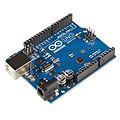



















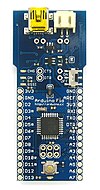

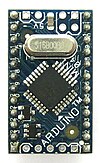







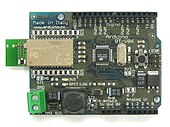


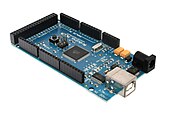




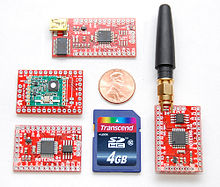









댓글
댓글 쓰기